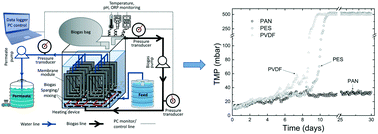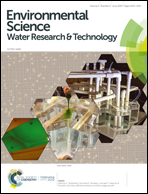Effect of ultrafiltration membrane material on fouling dynamics in a submerged anaerobic membrane bioreactor treating domestic wastewater†
Abstract
One of the main challenges in the realization of anaerobic membrane bioreactors (AnMBRs) for wastewater treatment is reducing membrane fouling. Although AnMBRs employ various types of membranes, the relationship between the surface properties of the membrane and the fouling dynamics of the AnMBR is unclear. To characterize this relationship, we studied the fouling of three types of morphologically comparable membranes with different physicochemical surface properties, which were installed simultaneously in a submerged AnMBR (SAnMBR) treating domestic wastewater, under a sub-critical flux and for various filtration durations (up to 30 days). For each membrane type, we characterized both the fouling rate and the foulant composition. We found that, during the first few days of operation, the fouling rate, which was low, and the foulants composition were similar for all three membranes. The fouling rate and fouling composition for the membrane with the high and positive surface free energy (i.e., hydrophilic) remained stable throughout the experiment, whereas, after a few days the two membranes that were characterized as hydrophobic (based on the low and negative surface free energy) experienced a sudden increase in the fouling rates and the foulant composition changed and resembled that of the mixed liquor in the SAnMBR. Statistical analysis clearly indicated that the surface free energy is the dominant parameter that controls fouling rates as well as the dynamic between the EPS components in the fouling layer. These results distinctly show that membranes with certain properties can affect fouling accumulation during filtration and physical cleaning efficiency to maintain low fouling, even in the complex environment of a SAnMBR. Higher flux recovery of the hydrophilic membrane measured after static (no flux) experiments and the fouling dynamic during batch filtration experiments support these findings. It can be concluded that the combination of physical cleaning and operating under sub-critical flux together with the optimization of the membranes properties can effectively control the fouling degree in SAnMBR. This, in turn, can lower the energy consumption for fouling control and thus promote the application of AnMBR for wastewater treatment. Further research on the effect of the membrane properties on the foulants composition, biofouling, and cleaning approaches is needed.



 Please wait while we load your content...
Please wait while we load your content...